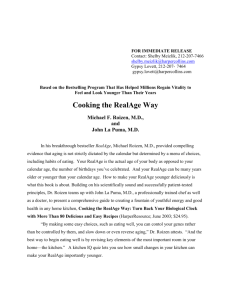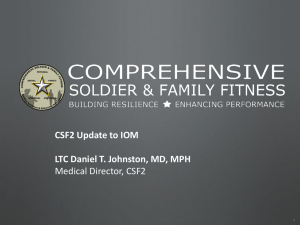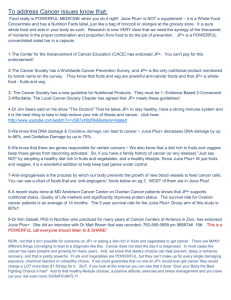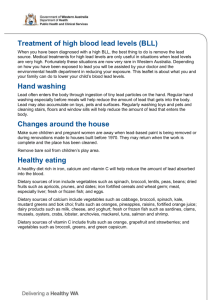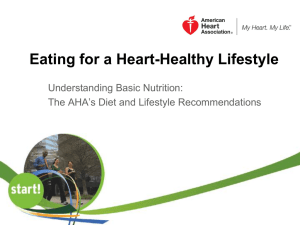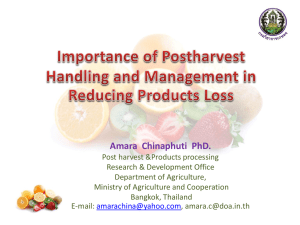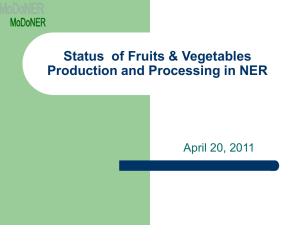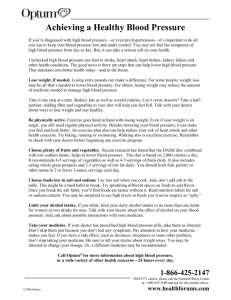File - Jennifer Housel
advertisement
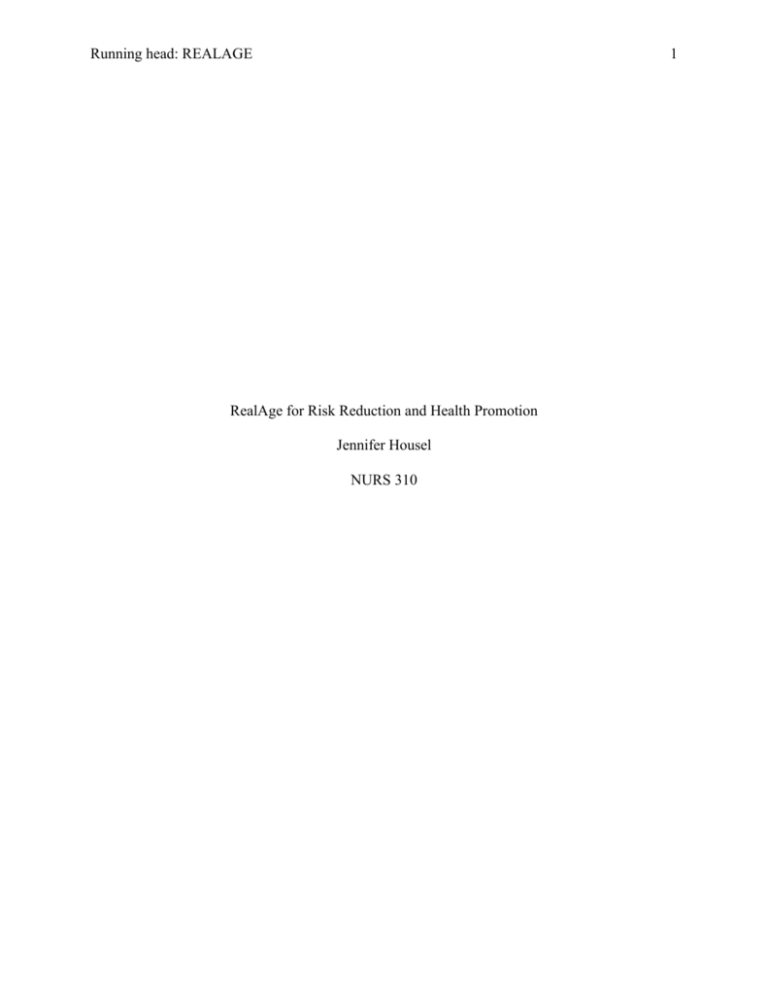
Running head: REALAGE 1 RealAge for Risk Reduction and Health Promotion Jennifer Housel NURS 310 REALAGE 2 Abstract The client completed the RealAge assessment online. Positive and negative health and lifestyle factors were identified which made the client either younger, or older, in physiological age. Diet was identified as the client’s greatest area in need of change. According to the transtheorectical model (TTM), the client was in the preparation stage of change. Therefore, the client had significant intention on changing her current diet. The wellness diagnosis for the client per Sparks and Taylor (2013) was readiness for enhanced nutrition. A personalized plan was developed according to the recommendations from Sharecare to increase intake of fruits and vegetables. The SMART goal made with the client was to increase fruit and vegetable consumption by including a serving at each of the three meals per day for the next month. Interventions were implemented, including the development of a food log for the client to record fruit and vegetable intake. Evaluation of the completed food log after 30 days displayed that the client had partially met her goal. In conclusion, the client increased her overall intake of fruits and vegetables. REALAGE 3 RealAge for Risk Reduction and Health Promotion The client has completed the RealAge test. The RealAge test is tool used to calculate the health of a client’s body. The test includes questions about health, feelings, diet, and fitness. The purpose of the test is to provide the client with personalized tips for becoming healthier by reducing risk taking behaviors and promoting health. The results of the test yielded positive and negative factors. The proposed solution for the client to grow younger includes a wellness goal along with multiple action plan interventions. A wellness diagnoses based on nutrition was made. In addition, two highly effective interventions based on evidenced based research have been implemented. The results from the RealAge test can suggest a significant difference in how old, or young, the client’s body thinks she is. Previously, the client only measured her age by the calendar since birth. This is important because after taking the test, the client is given a new number, along with a plan to grow younger. No other website has been as successful in gauging the physiological age of the body. The RealAge website has been widely popularized by television celebrities including Doctor Oz and Oprah. The client filled out a health history questionnaire, and then the website generated personal suggestions. The client was also given links to additional online articles and blogs, which yield helpful health advice. The client is a female born in 1987, which makes her calendar age 27. The client states that she feels moderately healthy. The RealAge test requests some levels from routine blood work. Luckily, the client was able to provide this information since she had her annual lab work drawn earlier this year during her yearly physical. She answered all the questions from the RealAge test to find out if she was physiologically younger or older. The REALAGE 4 hypothesis was made that the client’s RealAge would reflect that of a physiologically younger body. Assessment The client’s RealAge showed that she is 1.6 years younger, resulting in the age of 25.6 years old. The results of the RealAge test are divided into four sections including health, feelings, diet, and fitness. Each section is then further broken down to yield results as either positive or negative. Negative factors are those that make the client younger than her chronological age. Positive factors are the opposite, and make the client older. In addition there are neutral factors, which neither add nor subtract age. These factors are referred to as the client staying on track. Positive and Negative Factors Under the first section, health, the client did not gain any positive factors to make her grow older. She had equal results of staying on track and negative factors, which made her younger. Since the client was able to enter her lab values from her recent physical, she was informed that her cholesterol levels are healthy. According to Sharecare (2014) low total cholesterol offers maximum RealAge benefit. In addition, high-density lipoproteins (HDL), and low-density lipoproteins are explained on the website. Sharecare (2014) explains, “the higher your HDL, the more protection you have against arterial aging, heart attack, and stroke”. The next section is all about feelings. This was the client’s best section for reducing her chronological age. Almost all of her factors were negative, making her younger. One suggestion from Sharecare (2014) that was particularly humorous was to “pet your cat”. According to the website, the client is less stressed because she owns a cat. “Decreased life satisfaction, the development of mental disorders, the occurrence of stress-related illnesses (e.g., cardiovascular REALAGE 5 disease, gastrointestinal disorders, low back pain, headaches), and decreased immunologic functioning result from stress” (Pender, Murdaugh, & Parsons, 2011, p. 197). Therefore, keeping stress in check will continue to be an important factor for the client throughout her life. The third section, fitness, was not the client’s best area. Fortunately she has a job that keeps her active. The client’s lack of cardio is making her older. According to Sharecare (2014), “making 30 minutes of cardio part of your daily routine helps your heart, lungs, and circulatory system deliver oxygen and nutrients to your body’s cells and take away waste products”. The client states that she understands the importance of cardiovascular exercise, since she has completed a full marathon in recent years. Unfortunately, the client had the most positive factors under the diet section. The client had seven factors that are making her older. She only had three making her younger, which included eating more fish instead of red meat, and taking vitamin D. The client admitted while filling out the online questionnaire that she knew that her diet needed improvement. Luckily, the client received plenty of tips from the website for phasing out junk foods from her diet. It should be noted that the client was not recommended to eat less calories nor loose weight. Instead, the personalized recommendations included eating more grains, fruits, veggies, and nuts. According to the results from the RealAge test, diet appears to be the client’s greatest area of focus in need of change. Diagnosis According the RealAge results, the area in need of change is diet. The client has agreed to this area of focus. The client was further assessed according to the transtheoretical model (TTM) for readiness for change. TTM is “the basis for developing effective interventions to promote health and behavior change” (Velicer, Prochaska, Fava, Norman, & Redding, 1998, REALAGE 6 para. 1). The model includes five stages that the client progresses through when trying to adopt a new healthy behavior. According to TTM, the client is currently in the preparation stage, which is the third stage. The preparation stage, according to Pender et al. (2011), is when the client has put serious thought about changing a behavior (p. 51). The client completing the RealAge test, and having a plan to grow younger has demonstrated this stage. The wellness diagnosis for the client per Sparks and Taylor (2013) is readiness for enhanced nutrition. This wellness diagnosis has also been defined by Ackley and Ladwig (2011) as a pattern of nutrient intake that can be strengthened (p. 589). The client has a positive attitude towards eating a more nutritional diet. She has taken college courses based on nutrition in the past, and expresses knowledge of healthy food choices. The client is now ready for a plan to help her achieve her goal of eating healthier. Evidenced based research has shown the potential for fruits and vegies to boost the immune system. “A study done on women following breast cancer found that those who ate 5 to 9 fruits and vegetables per day, as well as exercising, had a reduced reoccurrence of cancer (Pierce et al, 2007). Planning The RealAge test not only provided the client with results, but also a plan for growing younger. The personalized recommendations provided suggestions to help the client improve her lifestyle. As previously discussed, many of the recommendations fell under the diet and fitness section. The plan formulated by the RealAge test to help the client grow younger included recommendations to boost whole-grain intake. The recommendations included eating foods such REALAGE 7 as shredded wheat, whole-grain bread, whole-wheat pasta, and popcorn. “Foods made largely from unprocessed grains contain more fiber and micronutrients” (Sharecare, 2014). The website also suggest eating at least four whole pieces of fruit a day to lower blood pressure, LDL, and the risk of heart disease and cancer. The client’s favorite suggestion was to “whirl up a smoothie” (Sharecare, 2014). A SMART goal focused on improving diet was made for the client. Goals A SMART goal is a goal that is specific, measurable, attainable, and realistically timebound. The goal made with the client was to increase fruit and vegetable consumption by including a serving at each of the three meals per day for the next month. The goal is specific because it states that the client will eat fruits or vegetables three times, each day. The client states that she likes this more than her previous personal goals of just increasing fruits and vegetables in general. The goal is measurable because the client either will, or will not, consume fruit and vegetables three times a day. The client has agreed to keep a daily food log for the next month. The goal is attainable because the produce is within the client’s budget. The client hopes to eventually like to eat 5 to 9 fruits and vegetables per day, but does not feel that is a realistically possible for her to achieve within the next 30 days. Interventions The client has made the goal to increase fruit and vegetable consumption in order to enhance personal nutrition. According to Ackley and Ladwig (2011), there are two main interventions can be implemented with the client (p. 590). First, determine the client’s motivation for changing eating habits. Second, develop with the client a method to keep a daily record of intake. The client has also agreed to keep a food log for 30 days in order to measure her progress towards her goal. For convenience, she kept the food log in the note-pad REALAGE 8 application of her smart phone. The food log will serve multiple purposes. Not only will it be used for evaluation, but also for intervention. A food log is a detailed record of food eaten during a specified time. A food log may also include information regarding triggers for decisions on what to eat. Emotions may serve as triggers for food intake. A study in the ScienceDirect journal showed correlation between caloric intake and emotions. The client states that she snacks on chips when feeling stressed while doing homework in addition to snacking on desserts when feeling happy. The study concluded, “positive emotions serve as an important but underinvestigated trigger for unhealthy food intake that deserves further scrutiny” (Evers, Adriaanse, Ridder, Huberts, 2013). It will be interesting to see if the client eats more fruits and vegetables depending on her mood. There is an additional benefit of using a food log to account for the frequency of fruits and vegetables consumed. The benefit is that the recording process itself influences food intake. The reason is because the food log has been proven to help “increase awareness of food choices” (DeBruyne, Pinna, & Whitney, 2008, p. 413). Therefore, the food log is not only a tool for evaluation, but also an intervention. The TTM “involves a reliance on self-report” (Velicer, Prochaska, Fava, Norman, & Redding, 1998, para. 3). A food log was developed for the client that had the dates pre-written on it for the next 30 days (see Appedix A). The food log also has space to write down if fruits or vegetables were eaten at breakfast, lunch, and dinner. Additionally, there is space next to each meal to record any triggers, such as emotions. Evidence-based research has shown that “development of selfmonitoring tools that meet the needs of clients increases dietary reporting and promotes selfefficacy” (Mossavar-Rahmani et al, 2004). REALAGE 9 Evaluation Progress toward the SMART goal will be evaluated by reviewing the food log. The food log will display the effectiveness of the nutrition interventions. Since the goal was partially met, the plan should continue to allow further progress. Motivational techniques may need to be altered. In addition, patient education on expected benefits should be provided. For example, providing facts on the improvement of hair, skin, and nail health may help motivate the female client. In general, the client felt that she made poorer food choices when in a bad mood. She felt that she ate more fruit on the days when she worked. This was because the client would pack her lunch the night before. Planning meals also played a part in vegetable consumption. When the client would plan meals with her boyfriend, she often ate green pepper or broccoli with her dinner. In conclusion, the client increased her overall intake of fruits and vegetables. The client’s intake of fruits and vegetables peaked after March 1st due to her mother lending her a juicer. The client was able to consume more than three servings of fruits and vegetables a day with consistent use of the juicer. REALAGE 10 References Ackley, B. J., & Ladwig, G. B. (2011) Nursing diagnosis handbook (9th ed.). St. Louis, MO: Mosby Elsevier. DeBruyne, L. K., Pinna, K., Whitney, E. (2008). Nutrition and diet therapy (7th ed.). Belmont, CA: Wadsworth/Thomson Learning. Evers, C., Adriaanse, M., Ridder, D., Huberts, J. (2013). Good mood food. Positive emotion as a neglected trigger for food intake. ScienceDirect Journal, 68, 1-7. doi:10.1016/j.appet.2013.04.007. Retrieved from http://0www.sciencedirect.com.libcat.ferris.edu/science/article/pii/S019566631300144X?via=ih ub Mossavar-Rahmani, Y., et al. (2004). Additional self-monitoring tools in the dietary modification component of the women’s health initiative. Journal of American Dietetic Association, 104(1): 76. Pender, N. J., Murdaugh, C. L., & Parason, M. A. (2011). Health promotion in nursing practice (6th ed.). Upper Saddle River, NJ: Prentice-Hall. Pierce, J. P., Stefanick, M. L., Flatt, S. W., et al. (2007). Greater survival after breast cancer in physically active women with high vegetable-fruit intake regardless of obesity. Journal of Clinical Oncology 25(17): 2345-2351. Sharecare (2014). The realage test. Retrieved from https://www.sharecare.com/assessments/realagetest/completed?recpage_id=745450 Sparks, S. & Taylor, C. (2013). Nursing diagnosis reference manual. New York, NY: Lippincott Williams and Wilkins. REALAGE 11 Velicer, W. F, Prochaska, J. O., Fava, J. L., Norman, G. J., & Redding, C. A. (1998). Smoking cessation and stress management: Applications of the Transtheoretical Model of behavior change. Homeostasis, 38, 216-233. Retrieved from http://www.uri.edu/research/cprc/TTM/detailedoverview.htm REALAGE 12 Appendix A
